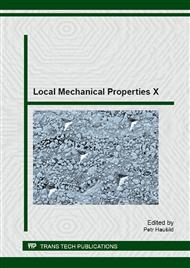p.133
p.137
p.141
p.145
p.151
p.155
p.159
p.163
p.167
Residual Stresses and Young's Moduli of Plasma Sprayed W+Cu Composites and FGMs Determined by In Situ Curvature Method
Abstract:
In this work, application of the in-situ curvature method on plasma sprayed composite and graded coatings is presented. First, uniform composites of different W/Cu ratio, were sprayed by water stabilized plasma. By continuous monitoring of the curvature of a flat specimen during spraying, the stress evolution throughout the entire history of coating formation was traced. By a simultaneous monitoring of curvature and temperature during post-deposition cooling, Youngs moduli of the coatings were determined. Second, a 5-layer stepwise functionally graded material (FGM) was sprayed. With the knowledge of each layers properties, the complex evolution of deposition, thermal and residual stresses in the FGM could be determined. The ability to determine the stresses and mechanical properties with a spatial resolution comparable to the thickness of one spray pass is demonstrated.
Info:
Periodical:
Pages:
151-154
Citation:
Online since:
March 2014
Authors:
Keywords:
Price:
Сopyright:
© 2014 Trans Tech Publications Ltd. All Rights Reserved
Share:
Citation:


